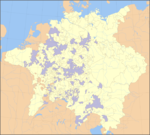- Mondsee Abbey
-
Imperial Abbey of Mondsee
Reichskloster MondseeImperial Abbey of the Holy Roman Empire ← 
←
788–831
1142–1791 →
→
 →
→The Collegiate Church of St Michael, Mondsee — formerly the monastery church Capital Mondsee Abbey Government Theocracy Historical era Middle Ages - Founded by Odilo,
Duke of Bavaria748 - Gained Imp. immediacy
after deposition of Tassilo III788 - Gifted to Regensburg Cathedral
by Louis the Pious
831- Regained independence
under Abbot Conrad II
1142- Mondseeland transferred
from Bavaria to Austria
1506- Dissolved by Leopold II 1791 - Granted to Bavarian
field-marshal von Wrede
1810 – ca 1815Today part of  Austria
AustriaMondsee Abbey (German: Kloster Mondsee) was a Benedictine monastery in Mondsee in Upper Austria.
Contents
History
The region of the Mondseeland, in which Mondsee is located, was formerly part of Bavaria. In 748 Mondsee Abbey was founded by Odilo, Duke of Bavaria. The abbey tradition was that the first monks came from Monte Cassino in Italy. In 788, after the fall of Duke Tassilo III, Mondsee became an Imperial abbey and over the centuries acquired extensive property. Around 800 the Codex Millenarius, an illustrated Latin book of the Gospels was written at the abbey. In 831 King Louis the Pious gave the monastery to Regensburg Cathedral.
It was not until 1142 that it regained its independence, under Abbot Conrad II, otherwise Blessed Conrad of Mondsee. Conrad,[1] formerly a monk of Siegburg Abbey, had been abbot of Mondsee since 1127, and was extremely successful in defending and regaining the rights and possessions of the monastery, to the extent that in 1145 he was murdered by a group of nobles at Oberwang nearby. He was venerated as a martyr and declared Blessed.
Conrad was succeeded as abbot by Blessed Walter of Mondsee (died 17 May 1158), long remembered as a model by the community for his exemplary striving after virtue. He was buried in St. Peter's chapel in the abbey church.
In 1506 possession of the Mondseeland passed from Bavaria to Austria. In 1514 Abbot Wolfgang Haberl established the abbey grammar school. After a period of decline during the Reformation and the consequent disturbances, the abbey entered a new period of prosperity. Under Abbot Bernhard Lidl (1727–73) and especially in connection with the celebration of the thousandth anniversary of the foundation, there was extensive re-building of the church and the monastic premises. From 1773 the abbot was Opportunus II Dunkl, who was the last abbot of Mondsee: in 1791 the abbey was dissolved by Emperor Leopold II.
From 1625 until its dissolution the abbey was a member of the Benedictine Austrian Congregation.
During the Napoleonic period the Mondseeland reverted to Bavaria for a few years. During that time, in 1810, the Bavarian Field Marshal Prince Karl Philipp von Wrede acquired the abandoned monastery (along with the nearby abbeys of Suben and Gleink), and used it as a castle. Wrede remained the owner even after the return of the territory to Austria and significantly developed the locality, for example by the construction of roads and the establishment of local cheese production. In 1905, on the death of Princess Ignazia von Wrede, Mondsee passed to the Counts Almeida, whose descendants sold it in 1985.
See also
References
External links
- (German) Mondseeland website
 Holy Roman Empire — Imperial abbeys of the Swabian College
Holy Roman Empire — Imperial abbeys of the Swabian CollegeImperial abbeys and colleges
(Reichsabteien, Reichsklöster
und Reichsstifte)Baindt • Comburg • Disentis • Elchingen • Frauenchiemsee • Fraumünster • Fürstenfeld • Gengenbach • Göss • Gutenzell • Heggbach • Helmarshausen • Herrenalb • Irsee • Kaisheim† • Lindau • Lorsch • Marchtal • Marmoutier • Maulbronn • Mönchrot • Mondsee • Murbach* • Neresheim • Ochsenhausen • Ottobeuren • Petershausen • Prüfening • Reichenau • Roggenburg • Rottenmünster • St. Gall's* • St. George's in Isny • Salem • Schänis • Schussenried • Schuttern • Söflingen • Ursberg • Waldsassen • Weingarten • Weissenau • WettenhausenImperial charterhouse
(Reichskartause)- Also a Prince of the Empire † Also in Rhenish College
Categories:- Imperial abbeys
- States and territories established in 788
- Former theocracies
- Former countries in Europe
- States of the Holy Roman Empire
- States and territories disestablished in 1791
- 748 establishments
- Christian monasteries established in the 8th century
- States and territories disestablished in 831
- States and territories established in 1142
- Monasteries in Bavaria
- Benedictine monasteries in Austria
- Buildings and structures in Upper Austria
Wikimedia Foundation. 2010.







